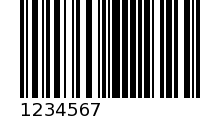
- #Barcode generator online install
- #Barcode generator online archive
- #Barcode generator online software
- #Barcode generator online code
#Barcode generator online code
Let’s start by generating a Code 39 barcode in Word. Your barcode font is now installed and ready to use! Generating Barcodes in Word You will have to close Word and reopen it in order to see the new font installed.ĭepending on which barcode font you download, you may see just the barcode in the list of fonts or you will see a name and then a picture of the barcode to the right.
#Barcode generator online install
Double-click on the font file and a window will pop up showing you the barcode font in different sizes.Ĭlick on the Install button at the top and the font will be installed into the C:\Windows\Fonts folder. Open the folder and you might see several files, one of them ending in TTF, which stands for True Type Font.
#Barcode generator online archive
Go to your downloads folder in Explorer, right-click on the archive and choose Extract All. Once you have downloaded the font, it will normally be included in a ZIP archive. If you’re going to use Word, you’ll have to live with one QR code storing just one letter, number or symbol.
#Barcode generator online software
So a five letter word like hello will look like this in Word when using a QR code font:Ī single QR code can actually store a lot of data, but that is only if you generate the QR code using third-party software or using a free online barcode generator. This is because it’s a font in Word and that means each letter has to have its own character. With QR codes and Word, the main problem is that each code square will end up being only one letter. Unfortunately, you can’t type these on your own and will have to first encode the text into the proper format and then paste it into Word. In addition to start and stop symbols, you also need some special checksum characters. So, you would have to type *Hello=John* in Word to get the text Hello John when scanned.įor Code 128, it’s not that simple. If you want to include a space in a Code 39 barcode, you have to use the equals symbol (=). For Code 39, all you have to do is add the start symbol (*) to the front and back of the text.įor example, if you download a Code 39 barcode, then you would type *Hello* to create a scannable barcode that will read the word Hello when scanned. Most 1D barcodes require a start and stop character in the barcode for it to be scannable. However, there are a few caveats about using barcodes in Word. With QR codes, you can store a lot of data and the size of the square will get bigger depending on the amount of data. Code 128 can handle a lot more text and the barcode will remain relatively small. You’ll notice the barcode becomes very long very quickly when using Code 39. My suggestion for most people is to use Code 39, Code 128 or QR code fonts as they are the most popular and the easiest to scan.Ĭode 39 is best for very short text, just a few characters. Either you can search Google for barcode fonts or you can download the one you want from these sites below. The patent was sold to a company called Philco in 1952 and then sold on to RCA.The first step is to download a barcode font and install it on your system. Woodland went to work for IBM, who researched the idea further, deciding that processing the information stored in these first barcodes needed technology that was unobtainable at the time. The patent was issued on 7th October 1952.



On 20th October 1949 Woodland and Silver filed a patent application entitled, "Classifying Apparatus and Method". Inspired by morse code, Woodland extended the dots and dashes downwards making wide and narrow lines of them. Woodland constructed his first barcode from sand on the beach. Undeterred, Woodland moved to Florida, but the pair continued on the project. They built a prototype and found that the inks faded over time. Woodland first had the idea of using ultraviolet light and an ink that was sensitive to the light. Together with Norman Joseph Woodland, Silver worked towards solving the problem. In 1948 a request was put to the institute to research a method of automatically reading the information about a product at checkout. Bernard Silver, a graduate student at the Drexel Institute of Technology in Philadelphia, USA, investigated a solution. As food chain stores began to grow into the giant super market chains we have today a need for reading product information at checkout was required.


 0 kommentar(er)
0 kommentar(er)
